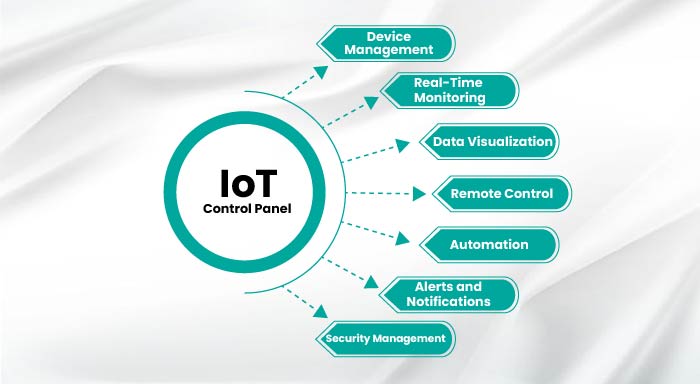Introduction
The Internet of Things (IoT) is a phenomenon that has already turned our world right side up given the connection orientation of the modern-day world. It is almost impossible to imagine modern life without smart systems, gadgets, and various types of Internet of Things.
But with this proliferation comes a challenge: how are we to govern and regulate all this multiplicity of devices? Here comes the IoT control panel, it is a single point of management, monitoring, and analysis of your IoT environment.
What is an IoT Control Panel?
An IoT Control Panel is a console or a graphic surface, either web or mobile resident that enables them to get access control of several IoT devices simultaneously. It works as the control hub that delivers real-time information and statistical information as well as control choices regarding other devices.
The Features of an ideal IoT control panel are as follows:
1. IoT Device Management:
This is enabled through management panels where users can make additions, deletions, or customization of the building blocks of IoT. This is well exemplified by device configuration, firmware upgrading, and authorization of device rights.
2. Real-time Monitoring:
All the online and connected devices can be monitored at once in terms of their status and performance. This comprises sensor data, the health status of the gadgets, and working conditions.
3. IoT Data Visualization:
Many control panels have graphic interfaces with any amount of graphs, charts, and other similar interfaces which make it simpler to comprehend trends and patterns created by the devices.
4. Remote Control:
The devices can be controlled remotely, thus, changing settings, powering ON/OFF the devices, and even triggering actions based on internet-connected space.
5. Automation:
It is also common to find that control panels readily include automatic settings and scenarios that are preprogrammed from the received data from the devices or other sources.
6. Alerts and Notifications:
Customers can set up notifications for certain conditions or when a certain value reaches its limit so that they are aware of certain conditions.
7. Security Management:
Most foundational device controls are found on the control panel, and these are controls to do with access, security, and encryption as well as security patching.
Advantages of Using an IoT Control Panel
1. Centralized Management:
In contrast to closely interacting with multiple applications or interfaces, it is much easier to control all the devices of the IoT from one panel.
2. Improved Efficiency:
As an outcome, those control panels assist users in perceiving the structure of the functional block of IoT ecosystem in detail and becoming more proficient at managing devices and resources more effectively.
3. Enhanced Decision Making:
Users can also identify their needs for IoT deployments and make the right decisions at the right time owing to the live information and analysis that would have been tricky in this age of technology.
4. Scalability:
As more and more IoT installations unfold, control panels help to avoid the feeling of losing track of numerous devices.
5. Customization:
Most of the control panels however can be personalized which means that the settings can be adjusted in the way that best suits the user.

Challenges and Considerations
While IoT control panel offer numerous benefits, there are also challenges to consider:
1. Security:
Since they act as a COMMON INTERFACE to one or more devices, control panels have to be VERY SECURE in order not to be manipulated or hacked easily.
2. Interoperability:
Mainly because there are numerous IoT devices and protocols in the market and it is quite difficult to get a compatibility interface with all.
3. User Experience:
It is essential to develop the actual interface to look simple and clear so that both newbies and simple users will be eager to apply this tool.
4. Data Management:
Being in charge of myriad IoT devices, the control panels should be always able to manage the incoming data stream and accommodate it without being drowned in the records.
Internet of Things Control Panels in the Future
With time, control panels based on IoT will advance by levels and this view will become popular. Some trends to watch for include: Some trends to watch for include:
1. AI Integration:
AI and especially machine learning will increase their importance for analyzing the data, performing tasks in maintaining and predicting the machinery and systems, and automated decision processes.
2. Voice and Gesture Control:
Gesture recognition and natural language processing may provide approaches to controlling IoT devices using control panels.
3. Augmented Reality:
AR interfaces could offer better intuitive action for interaction with IoT levels and connected spaces.
4. Edge Computing:
When more processing shifts towards the cloud, the control panels will have to incorporate control of both cloud and edge IoT implementations.
Conclusion
IoT control panels present themselves as a necessity as managing IoT systems becomes increasingly indispensable in the modern world. These interfaces for platforms concerned with device management, data interface, and control allow users a way to optimize their applications regarding their IoT projects.
Thus, the IoT control panel will become only a more central device influencing the manner of connection to the Internet of Things and Cloud utilization in the future with further development of advanced technologies.
Related Posts
Communication Protocols In IoT | How Do IoT Devices Interact?
Learn the Ideas Behind the Logical and Physical Designs of IOT



